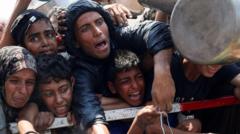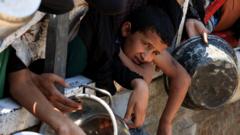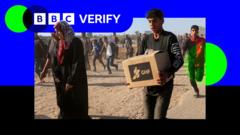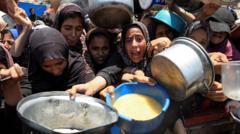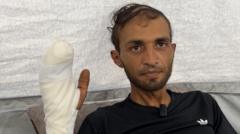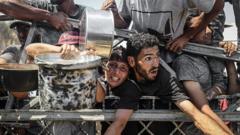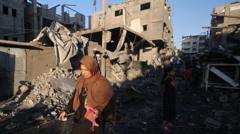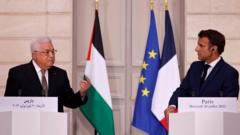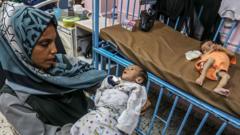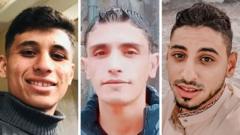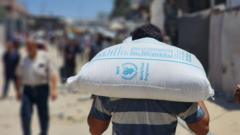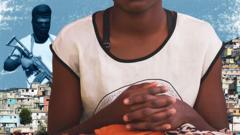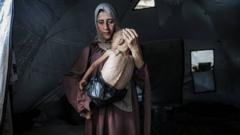The grim situation surrounding aid distribution in Gaza was further exacerbated during a 'women-only' day, where chaos resulted in the deaths of two women seeking food assistance. The Gaza Humanitarian Foundation's initiative highlights the fragility of humanitarian efforts amid ongoing violence and loss of civilian life.
Tragic Consequences of Gendered Aid Distribution Amidst Conflict in Gaza
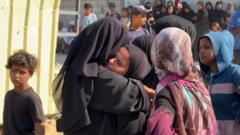
Tragic Consequences of Gendered Aid Distribution Amidst Conflict in Gaza
A 'women-only' aid distribution in Gaza aimed at providing food assistance escalated into chaos, leading to the tragic death of two women, including a mother of seven.
In a disturbing turn of events during a specially designated 'women-only' aid distribution in Gaza, two women lost their lives while attempting to secure food for their families. Mary Sheikh al-Eid, a mother of seven who had been struggling to feed her children after the loss of her husband, was among those killed, highlighting the dire circumstances faced by many in the region.
The Gaza Humanitarian Foundation (GHF) announced the initiative through social media, encouraging women to attend the morning food box distribution without the presence of men. While this approach aimed to create a safer environment for women navigating the chaos surrounding aid points, it nonetheless failed to prevent violence.
Witnesses described a scene of pandemonium as large crowds of women gathered at the distribution point in Rafah. Eyewitness Khawla Sheikh al-Eid recounted the chaos, which quickly turned violent as private security and Israeli troops attempted to control the crowd using pepper spray and stun grenades. In the mayhem, Khawla and her sister Mary became separated, leading to the tragic news that Mary had been shot.
Reports indicate that following the establishment of the GHF's aid distribution model, over 1,000 Palestinian civilians have been killed in clashes near these sites. Critics argue that the new system imposes increased military control over humanitarian aid and compromises civilian safety. Former U.S. soldier Anthony Aguilar described the scene he witnessed as brutal, with excessive and indiscriminate force being used against unarmed civilians.
The impact of the ongoing conflict has drawn widespread condemnation from international organizations and European governments, amplifying calls for a re-evaluation of aid distribution methods in Gaza. As food insecurity escalates, humanitarian officials warn of impending disaster without immediate and substantial aid.
Despite claims from Israel that it aimed to prevent aid manipulation by Hamas through the GHF initiative, the approach has drawn severe criticism. Many are left to question the safety and efficacy of such distributions, with one family member poignantly stating that the aid sites have become "death traps."
The dire situation underscores the urgent need for a sustainable and safe approach to addressing humanitarian crises in conflict zones, prioritizing civilian safety above all.
The Gaza Humanitarian Foundation (GHF) announced the initiative through social media, encouraging women to attend the morning food box distribution without the presence of men. While this approach aimed to create a safer environment for women navigating the chaos surrounding aid points, it nonetheless failed to prevent violence.
Witnesses described a scene of pandemonium as large crowds of women gathered at the distribution point in Rafah. Eyewitness Khawla Sheikh al-Eid recounted the chaos, which quickly turned violent as private security and Israeli troops attempted to control the crowd using pepper spray and stun grenades. In the mayhem, Khawla and her sister Mary became separated, leading to the tragic news that Mary had been shot.
Reports indicate that following the establishment of the GHF's aid distribution model, over 1,000 Palestinian civilians have been killed in clashes near these sites. Critics argue that the new system imposes increased military control over humanitarian aid and compromises civilian safety. Former U.S. soldier Anthony Aguilar described the scene he witnessed as brutal, with excessive and indiscriminate force being used against unarmed civilians.
The impact of the ongoing conflict has drawn widespread condemnation from international organizations and European governments, amplifying calls for a re-evaluation of aid distribution methods in Gaza. As food insecurity escalates, humanitarian officials warn of impending disaster without immediate and substantial aid.
Despite claims from Israel that it aimed to prevent aid manipulation by Hamas through the GHF initiative, the approach has drawn severe criticism. Many are left to question the safety and efficacy of such distributions, with one family member poignantly stating that the aid sites have become "death traps."
The dire situation underscores the urgent need for a sustainable and safe approach to addressing humanitarian crises in conflict zones, prioritizing civilian safety above all.

